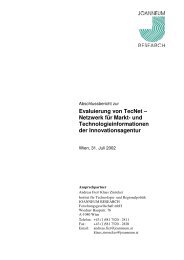23.11.2011 Ausgabe 36 - fteval
23.11.2011 Ausgabe 36 - fteval
23.11.2011 Ausgabe 36 - fteval
Erfolgreiche ePaper selbst erstellen
Machen Sie aus Ihren PDF Publikationen ein blätterbares Flipbook mit unserer einzigartigen Google optimierten e-Paper Software.
The organisation generally achieved to maintain regular contact (about 5 times between CC1 and CC2) with participants<br />
throughout the relatively long period between the two consultations of about one and a half year. The project<br />
duration was justified by the need to develop some of the organisational and analytical tools during the project and<br />
the need for constantly translating all materials so that visions and recommendations were always accessible in the<br />
national languages. This consumed significant resources. Although acknowledging these difficulties we think that such<br />
a process would need to be speeded-up significantly if the CIVISTI method should become a wider used model of citizen<br />
participation.<br />
After a first established contact with the citizens via telephone, citizens who agreed to participate in the consultations<br />
received an information brochure which was primarily designed to raise people’s interest in S&T issues and to inspire<br />
their visions on the future of Europe. It was, however, not designed to provide specific content for the following citizen<br />
consultation. In contrast to other models of citizen consultation CIVISTI did not intend to prepare citizens for certain<br />
thematic fields, neither through information or expert input. This meant that visions actually had to be developed adhoc<br />
at the first citizen consultation.<br />
Quality and quantity management<br />
In order to establish a continuous involvement of citizens and to sustain creative momentum, it was crucial to have<br />
standardised, well designed working methods and a well structured organisational framework. These core aspects of<br />
the consultation process were fulfilled by CIVISTI and positively determined the quality of the process itself (which<br />
should also be reflected in citizens’ perspectives). In addition, a continuous “output control” was necessary in terms of<br />
ensuring the quality of the produced results (often written documents) at each stage of the process. The final output<br />
– after all the efforts that go into the process – is a list of 30 recommendations validated by experts and citizens. To<br />
ensure that this output entails the added-value of citizen participation (citizens’ visions, knowledge, opinions, ideas etc)<br />
and is at the same time adapted to research planning processes is – simply put – a very difficult job.<br />
We will describe three layers of quality management in the CIVISTI process, which also include elements of “quantity<br />
management” (management of the quantity of produced materials):<br />
. Methods: Combination of single work, group work, feedback, voting and ranking, templates and<br />
written accounts, cross validation (citizens experts)<br />
. Facilitators: Support by facilitators throughout all stages<br />
. Organisational setting, structure and agenda<br />
The observation (as well as the questionnaire survey) showed that CIVISTI methods generated a high participant engagement.<br />
From other citizen consultations in Austria as well as from CIVISTI we had the impression that participating<br />
citizens have one clear expectation: To work on their ideas. They consciously invest their time for that purpose and not<br />
for listening to lengthy expert or politician monologues. CIVISTI methods therefore created “working environments”<br />
and organisational settings and agendas that focused on dedicating as much time as possible to the citizens’ own work.<br />
This meant that consultations proceeded very fast with introductions and dispensed with inputs from experts or other<br />
35<br />
Nr. <strong>36</strong><br />
06/2011<br />
“stakeholders”. The emphasis was on clear task descriptions which were done by professional facilitators. The overall<br />
agenda has to be described as being very strict and tight (nearly two days of work for citizens and facilitators in CC1)<br />
but organised in a way that made participation as comfortably as possible for citizens, which included organisational<br />
aspects such as an “all-inclusive” stay in a seminar hotel, good catering, sufficient breaks between work tasks and a reimbursement<br />
for participants – only side remarks for an evaluation but crucial aspects for the functioning of the process<br />
itself. The citizens’ feedback on these aspects was overwhelmingly positive and manifested in a strong motivation.<br />
The CIVISTI methodology tried to focus citizens’ attention to social and technological change through a short series<br />
of creativity exercises which connected past, present and future as well as everyday life concerns, national concerns<br />
and finally European concerns. Citizens then started to work on their own vision (single work, no group), and – judged<br />
from our observation – without experiencing severe difficulties in doing so. In Austria as well as in Bulgaria all citizens<br />
managed to produce a so called “rough vision” on a variety of themes even without a specific thematic framing or comprehensive<br />
pre-information. These individual visions were refined in a series of feedback exercises (between persons<br />
and then between groups), allowing citizens to take on a more distanced and critical role when commenting on other<br />
citizens’ visions. They became “evaluators” themselves and had to think about criteria how to assess a vision. This<br />
generated a “rationalisation” in terms of reflecting a vision without the strong individual cognitive and emotional involvement<br />
that was sometimes observable when participants worked on their own ideas. This “rational” approach was<br />
also present when citizens were voting for visions. The voting clearly had a quality management aspect to it – Visions<br />
which were not elaborated very well, or inconsistent or which were dealing with non-significant topics were often not<br />
selected by the citizens for the next round. Most citizens also respected the legitimacy of the resulting vote – even if<br />
this meant that there own vision would not make it to the next round. In this regard the voting also achieved a “quantity<br />
management” in reducing the number of visions and complexity which became more and more important during the<br />
process. Of course there are losses: Important topics may not be represented (e.g. environmental issues in Austria)<br />
and participants may loose some of their emotional involvement when their vision is not voted for, which could also<br />
be observed. These “losses” however did not seem to interrupt the process. Only in CC2 – after significant participant<br />
attrition – it became evident that non-presence of original authors made it sometimes more difficult for the remaining<br />
citizens to relate to a topic.<br />
Facilitators in CIVISTI were persons who moderated group discussions, explained tasks and templates, gave advice<br />
when participants asked for it, provided overall guidance etc. While their role was generally described as non-intervening<br />
(they should not actively bring their values and expertise into discussions), it was by no way a completely<br />
passive role. It seems that their role is particularly important when it comes down to “objectifying” the results of the<br />
consultation in written form as visions or recommendations. This stage was mostly characterised by time pressure and<br />
the immediate need to close discussions, find consensus and formulate ideas in a comprehensible way that fits the<br />
template. Citizens as well as experts needed guidance at this stage and facilitators needed clear instructions or even<br />
trainings to provide appropriate support. CIVISTI facilitators were often part of the scientific staff of the participating<br />
partners. The instructions in particular in CC1 for facilitators were very accurate and written down in a manual that<br />
described the activities at every stage in detail. Furthermore the consortium seemed to be highly sensitive to the question<br />
of behaviour towards citizens.<br />
<strong>36</strong><br />
Nr. <strong>36</strong><br />
06/2011


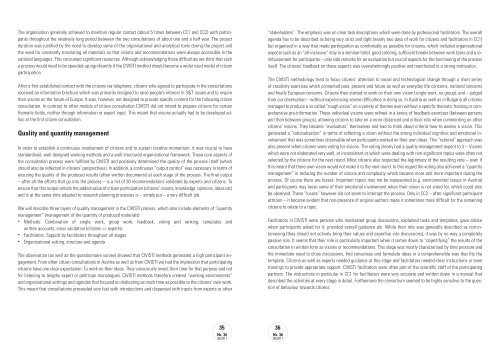

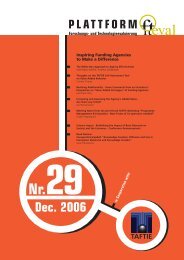
![roadMAP [PDF, 1.9 MB] - fteval](https://img.yumpu.com/21079876/1/184x260/roadmap-pdf-19-mb-fteval.jpg?quality=85)
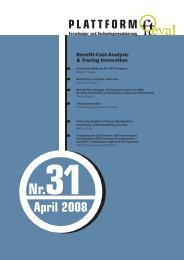
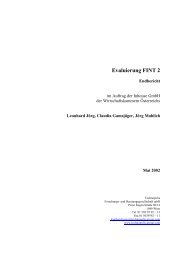
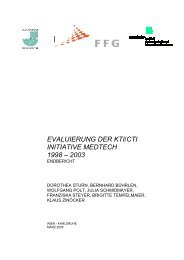
![GuggenbergeronBoku [PDF, 73.4 KB] - fteval](https://img.yumpu.com/21024081/1/184x260/guggenbergeronboku-pdf-734-kb-fteval.jpg?quality=85)
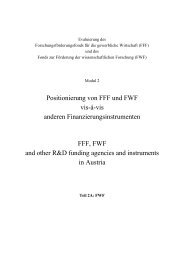

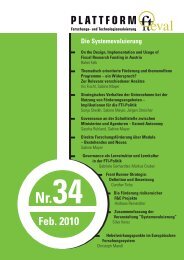
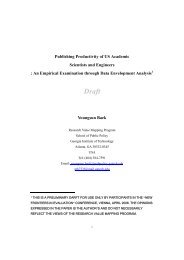
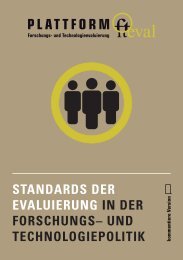
![ITF_Energietechnik [PDF, 39.6 KB] - fteval](https://img.yumpu.com/20959076/1/184x260/itf-energietechnik-pdf-396-kb-fteval.jpg?quality=85)
![Evaluation Standards [PDF, 120.8 KB] - fteval](https://img.yumpu.com/20931509/1/184x260/evaluation-standards-pdf-1208-kb-fteval.jpg?quality=85)
